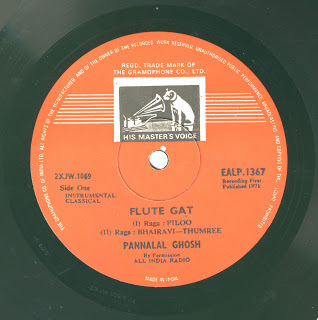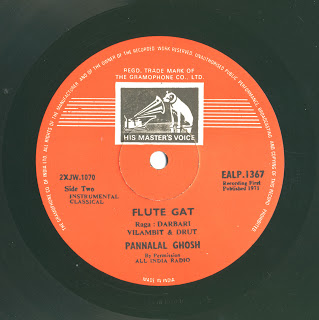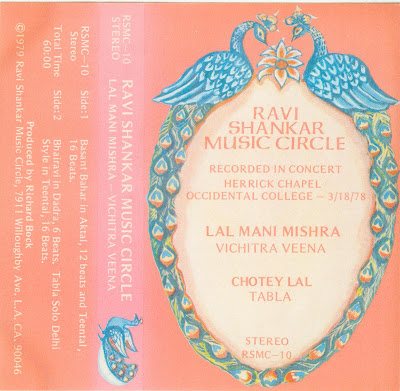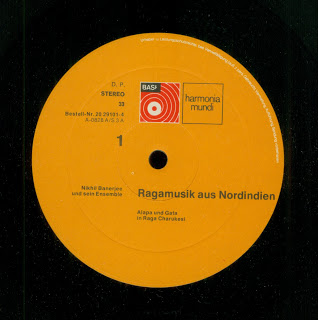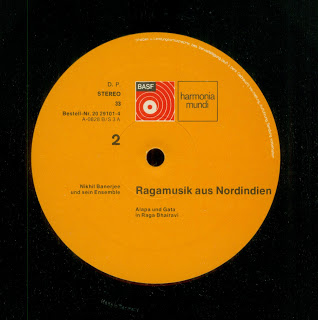Side 1:
Thumri - Misra Tilang
Side 2:
1. Tappa - Bhairavi
2. Dadra - Gara
Smt. Siddheswari Devi

With the passing away of Siddheswari Devi on March 18 1977, the last of the four great pillars of Hindustani light classical music is gone. First went Begum Akhtar in 1974 at the age of 60, and then her older contemporaries, Rasoolan Bai, Badi Moti Bai and Siddheswari Devi. All four of them were inheritors of great traditions of music from a glorious era of the past when music dominated the lives of musicians from childhood to death. They were musical `stars' who shone brilliantly in the courtly era; but when the `darbari' era ended they did not hesitate to step out into the glare of public acclaim.
Thumris were once sung with abhinaya. When classicists began to frown down on this type of music with abhinaya, the singers took to the Bol-Banav-ki Thumri in which the emotional contents of songs are effectively brought out through vocal expressiveness only, that is, beauty of notes, voice modulations swara-combinations, and a specially emotion-charged style of singing. Bhaiya Ganpatrao, Moizuddin, and Shyamlal Khatri were some of the trail-blazers who gave this modern orientation to Thumri. Among those who have kept up these traditions till now in full glory, the outstanding names of this century have been Siddheswari Devi, Rasoolan Bai, Badi Moti Bai, Begum Akhtar, Mahadev Prasad Misra, and Girija Devi. Girija Devi is far younger than the others, and is of a different generation.
Born into a famous musical family in Varanasi in 1903, Siddheswari traced her musical lineage to her maternal grandmother Maina Devi, a reputed singer of Kashi of nearly a century ago. She was the inheritor of great musical traditions from a family which produced several famous singers like Maina Devi, Vidyadhari Devi, Rajeswari Devi and Kamaleswari Devi. As Siddheswari lost her mother when she was barely 18 months old, she was brought up by her maternal aunt, Rajeswari, who was a famed disciple of Maina Devi, Mithailal, and of the great Moizuddin himself. Brought up in this musical atmosphere, Siddheswari absorbed a great deal of the art right from her infancy. Her childhood was an unhappy one as she lost her father also very soon. About this period of her life, she once said : "We did not have luxuries like the gramophone. But our neighbours had one. I used to go to them to listen to the records of popular singers like Janaki Bai, Gauharbai and several others. How their music used to captivate me!".
Noticing the talent and eagerness of the young girl, Siyaji Maharaj began to teach her. Siyaji's father Shyamacharan Misra, and uncle Ramcharan Misra had been good musicians. About her guru, Siddheswari used to say : "No one could possibly get a more generous and affectionate guru. Having no children of his own, he treated me like his own daughter. He taught me all the basic ragas and a large number of Khayals, Tappas, and Taranas. He taught me with all his heart, and I practised my music with intense concentration and devotion. Nowadays, alas! the students are all in a hurry to acquire a diploma or a degree; they have no lagan."
After the death of Siyaji Maharaj, she learnt for a while from Ustads Rajab Ali Khan of Dewas, and Inayat Khan of Lahore. However, her greatest guru, the one to whom she attributes most of her musical training was none other than Bade Ramdasji of Varanasi. Her face glowed with pride and veneration whenever she spoke about this generous guru who taught the eager disciple magnanimously. Nostalgically recalling those times of close guru-shishya bonds, Siddheswari once remarked to me : "The age of such great and generous gurus seems to have gone. No longer does one come across the really devoted type of pupils either. Today they are all in such a hurry----"
Later on in life, when she joined the Bharatiya Kala Kendra in Delhi as a professor, she earned the reputation for being a sincere and conscientious teacher. When I mentioned this to her, she simply remarked : "Why not, Beti? Let something of my treasures remain with others after l am gone".
Siddheswari made her unforgettable debut at a Calcutta conference many many decades ago. Young Siddheswari's name was billed along with those of many of the veterans of the time, such as Pt. Omkarnath Thakur, Pt. Dilip Chandra Vedi, Ustad Faiyaz Khan and others. Her khayals in Malhar and Suha-Sughrai, and her thumris, elicited high praise and medals galore from Pt. Omkarnathji and Ustad Faiyaz Khan. Another glorious performance of her's was in the All India. Music Conference in Bombay in which Ustads Bade Ghulam Ali Khan and Faiyaz Khan also were to sing. Siddheswari concluded her superb recital with such an intensely emotional rendering of the Bhairavi-Thumri (Kaahe Ko daari re gulal Brajlal Kanhayi) that the Aftab-e-Mausiqui refused to sing after her! He said to her : "After such music there is no room for any more. After Gauhar Malika, the crown of the Thumri rests on your head". Such was the grand magnanimity of the musical giants of the past!
After her first concert appearance at the age of 18, she began to receive invitations for performances in Rampur, Jodhpur, Lahore, Mysore and various other states which used to patronise classical music during that time. In the next 4 or 5 decades, she sang in many royal durbars, music conferences national programmes, radio concerts and so on until she became "an institution by herself in view of her enormous repertory and heritage of a rich musical tradition." In recognition of her valuable contributions to the enrichment and perpetuation of the Banaras (Poorab) ang of light classical music, Siddheswari was honoured with the Presidential Award in 1966, the Padmasri in 1967 the D. Litt from Rabindra Bharati University, Calcutta, and the title of "Desikottama" from the Viswa Bharati University. When we felicitated her on the Award, her humble and philosophical reply was : "It's all very well; but I shall continue to deserve these, only as long as I can go on singing well enough to please you all". In spite of all the fame that she earned, she remained simple, unassuming and homely till the end. Among contemporary musicians, Kesarbai Kerkar and M.S. Subbalakshmi were the artistes she admired most.
Few musicians in recent times had such a vast repertoire as Siddheswari had. Her rich storehouse included a large number of Khayals, Thumris, Dadras, Tappas, Kajaris, Chaitis and Bhajans. "A feeling heart, a fecund mind, and an expressive voice" are the prime requisites for a good light classical singer. Even when her voice had become "temperamental and thick" in old age, she could make up for it by a rare emotional fervour, and she could hold her audiences by her mood of intense absorption and her ability to bring out the emotional contents of the romantic or devotional themes. Siddheswari's music brought out all the salient features of the Banaras style, such as simple charm, intensity of feeling, and effective expression of emotions through sheer purity of notes, "meends" and voice modulations. She said to me once : "Although my thumri is fully of the Banaras ang, I incorporate elements of the Khayal into it. You may say that my thumri- singing is Khayal angapradhan". She added spice and charm by sprinkling short, swift tappa-like taans and trills. In her early days, she was deeply impressed by the singing of Gauharjan, Zohrabai, and Malikajan. As a member of cultural delegations, Siddheswari gave recitals in Rome, Kabul, and Kathmandu.
Siddheswari cherished not only the songs galore that she had learnt from her revered guru Bade Ramdasji, but also the lofty principles that he impressed on his disciples. He used to advise her: "Music is the medium for pleasing and attaining God. You should never feel proud of any success. Always remain humble. The day your tears flow during your sangeetsadhana, your music will have attained mellowness and maturity".
No wonder she always believed that both "Siddhi" and "Ishwar" can be attained through devoted sangeet-sadhana. Her deeply religious temperament had a great impact on her singing. In the last years of her life, the Pukaars in her Thumris and Bhajans were like cries from an anguished devotee's heart. With eyes closed, mind absorbed, and left hand cupping her left ear (to receive the full drone of the Tanpura), she used to pour her heart out through her music. Siddheswari remained a most warm-hearted, simple, and loveable person, "an extraordinary amalgam" of innocence, courage, humour, generosity, youthful zest for life, and a rare dignity. Her life was, by no means, a happy or smooth one. She had an unhappy childhood and "an emotionally tumultuous" youth, and she had to undergo many bitter experiences in life. But all of these seem to have added to her natural dignity, strength and wisdom. One of her admirers described her as "a vast reservoir of warmth, an unfailing fountainhead of inspiration, a manifestation of humanity at its most compelling and earthy.... and yet a being full of sparks and sudden vertical ascents to the mystic regions where inspiration has its divine origins". She did not have the facilities to devote herself to sadhana; living like a recluse. She practised her music all the time, while she was cooking, washing clothes, or doing any of the ordinary household chores. Music was her very Iife.
The death of Siddheswari Devi has left a big void in the world of light classical music. Shanta Devi, her elder daughter whom she had trained up to follow her footsteps has remained in obscurity owing to poor health. Surprisingly, it is her younger daughter Savita Devi who has zoomed into the limelight as a delightful and popular singer, and it is Savita who shows every sign of taking her illustrious mother's place. Versatile and attractive Savita is not only a graduate (an M.A, and Sangeetalankar) and a good Sitariya, but she has also shaped into a confident and popular vocalist with a wide repertoire of Khayals, and light classical varieties. Gifted with an appealing, melodious voice covering 3 octaves or more, she has undergone years of training in khayals under Pt. Moni Prasad of the Kirana gharana. She has a natural flair for the light classical varieties in which she was extensively trained by her mother whom she used to accompany as a supporting singer in many concerts. While working as Head of the Department of Music in Daulatram College (University of Delhi), she is continuing her own music riyaz tirelessly.
Many years before her death, Siddheswari had once told me : "My greatest ambition is to die while singing a perfect taan. I feel closest to God when I am lost in my music." Begum Akhtar also had expressed an almost identical wish which was fulfilled because she died in the peak of her glory, giving a memorable performance before the dropping of the final curtain.
But Siddheswari who lived till her seventies, had no such luck. She had been helplessly bed-ridden for many months prior to the sad end. In a TV interview prior to her last illness, she had confessed with dignity:- "There was a time when I used to sing for the public. Now I sing to please my God. My soul craves to go back to its original abode".
Malini Menon, one of Siddheswari's pet-pupils who had become more like a daughter to her, writes:- "Maa remained a student all her life. . .She had a child-like thirst for knowledge and she was ever so generous as she could not bear to see anybody in want... Maa was turbulent as the waves, and yet calm like the distant sea. She was at peace with herself and had prepared for the journey of the soul to eternity. When the moment came, she accepted it with grace."
Siddheswari Devi's last brilliant recital was in the Radio Sangeet Sammelan (a couple of years before her end) in which she sang with a bubbling, youthful zest, accompanied on the Sarangi by Pt. Gopal Misra (who is no more), and on the Tabla by Ramji Misra. Eyes twinkling, the solitary diamond in her big nose ring flashing points of light, a warm smile on her paan-reddened lips, Maa's homely figure emerges in one's memory. But as soon as she sat on the stage for a recital, one realised that she belonged to an entirely different world, and that her life had known "no horizons other than music". As I recall that last inspiring recital of hers in the Radio Sangeet Sammelan, memories of several other great past concerts of this music-devotee come to my mind, and her plaintive Jogiya echoes in my memory:"O Jogi ! Constantly uttering the name of Rama, you have become one with Him, leaving your little hut so empty---".
Posted on RMIC by Rajan Parrikar as part of Great Masters Series.
From:
"Great Masters of Hindustani Music" by Susheela Misra.
![[RMM.jpg]](../../../3.bp.blogspot.com/_ikNA-qTOdWM/SloNq4JTOfI/AAAAAAAAAkQ/fO6tUvN_NXw/s400/RMM.jpg)
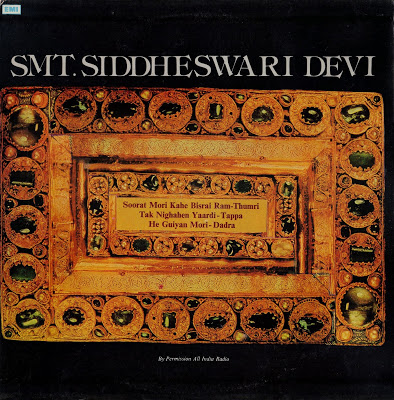
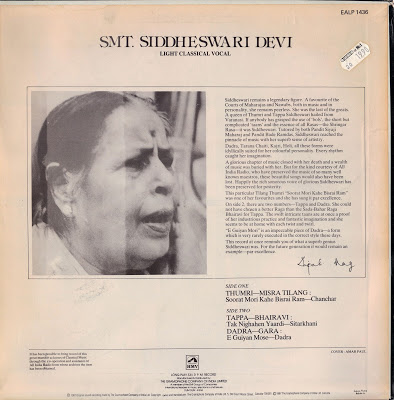
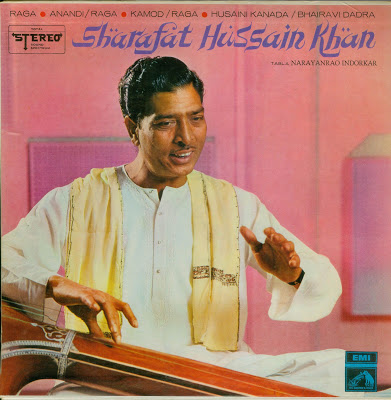
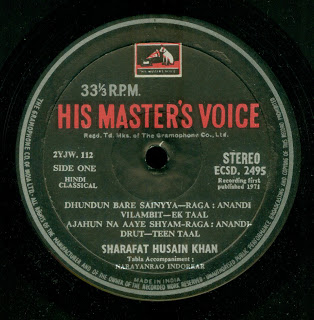
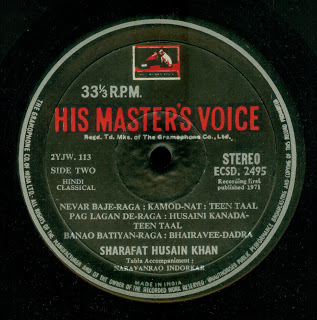
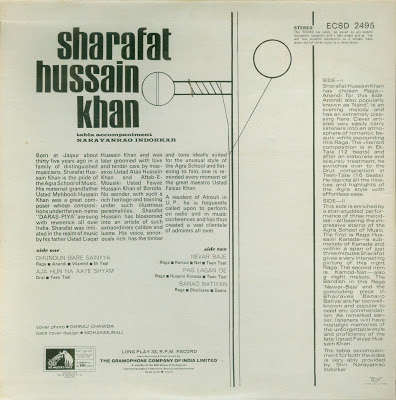
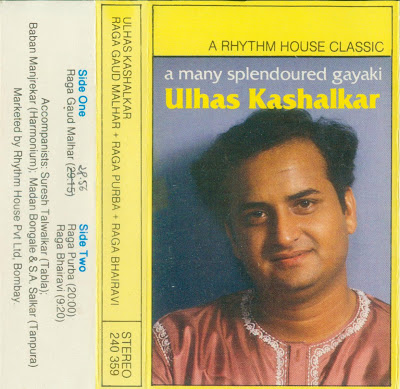
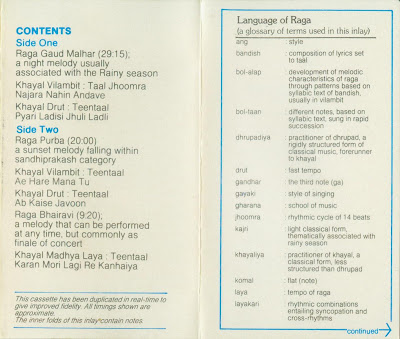
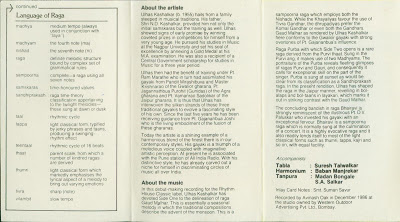
.jpg)
